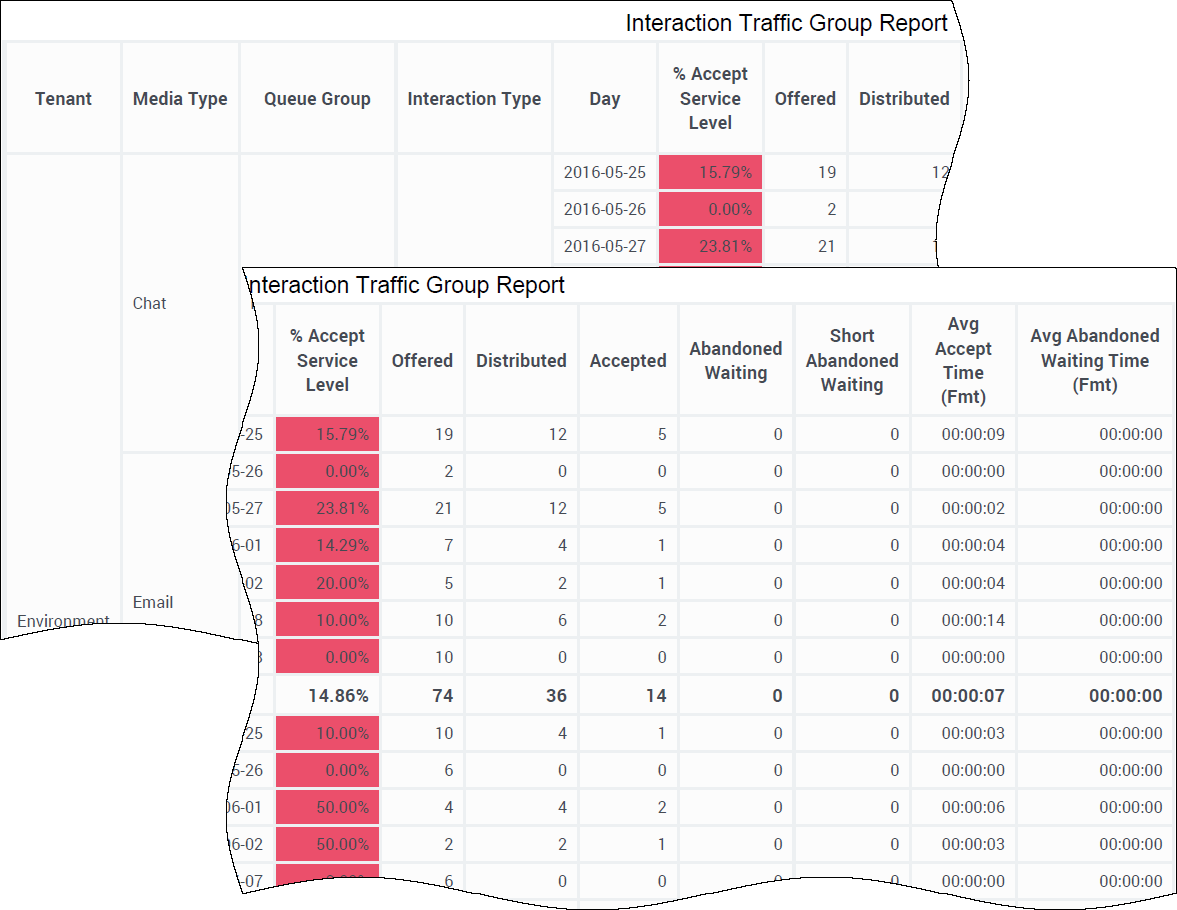Contents
Interaction Traffic Group Report
This page describes how you can use the (Queues folder) Interaction Traffic Group Report to see detailed information the efficiency of interaction handling, by queue group.
Understanding the Interaction Traffic Group Report
This report summarizes contact center activity as Interactions are offered to, abandoned within, and distributed from queues that belong to one or more queue group(s), including overall percentages of service level, and exceptions to service level. Mediation DN activity is rolled up to all of the groups to which the DN belongs. Counts and durations are attributed to the interval in which the interaction enters the mediation DN.
Use this report to better understand the efficiency of interaction handling in each queue group, at a high level, including summaries of interactions offered, accepted, and abandoned, and the average times to accept or abandon.
To get a better idea of what this report looks like, view sample output from the report:
HRCXIInteractionTrafficGroupReport.pdf
The background color of data cells in this report serve to alert you to values that are outside of configured threshold ranges.
The following tables explain the prompts you can select when you generate the report, and the metrics and attributes that are represented in the report:
Prompts for the Interaction Traffic Group Report
| Prompt | Description |
|---|---|
| Pre-set Date Filter | From the list, choose a time period on which to report, and move it to the Selected list. |
| Start Date | Choose the first day from which to gather report data. |
| End Date | Choose the last day from which to gather report data. |
| Queue Group | Optionally, select a queue on which to report. |
| Media Type | Optionally, select the type of media to include in the report—for example, VOICE, EMAIL, and CHAT. |
| Interaction Type | Optionally, select the type of interaction to include in the report—for example, Inbound, Outbound, and Internal. |
| Tenant | For multi-tenant environments, optionally select the tenant(s) for which to include data in the report. |
Attributes used in the Interaction Traffic Group Report
| Attribute | Description |
|---|---|
| Tenant | This attribute enables data within the reporting interval to be organized by tenant. |
| Media Type | This attribute enables data to be organized by the interaction’s media type—for example, VOICE, EMAIL, and CHAT. |
| Queue Group | This attribute enables reporting data within the reporting interval to be organized by the name of the queue group. A queue can belong to more than one queue group. |
| Interaction Type | This attribute enables data to be organized by the interaction’s type—for example, Inbound, Outbound, and Internal. |
| Day | This attribute enables data within the reporting interval to be organized by a particular day within a month and year. Day values are presented in YYYY-MM-DD format. |
Metrics used in the Interaction Traffic Group Report
| Metric | Description |
|---|---|
| % Accept Service Level | The service level of this queue group measured as a percentage of interactions that entered queues that belong to this queue group and were accepted within the acceptance threshold, relative to all interactions that entered queues that belong to this queue group and were offered to a resource.
This metric yields results other than 0 only for interactions that were accepted by an agent. This metric relies on the value of the acceptance threshold as configured in the [agg-gim-thld-QUEUE-IXN] section. |
| Offered | The total number of interactions that entered queues that belong to this queue group and were subsequently offered to a resource.
The count excludes short-abandoned interactions and includes handling attempts that agents rejected, as well as warm consultations, conferences, and collaborations that agents received. This metric does include interactions for which no threshold was set by Router. This metric relies on the value of the short-abandoned threshold as configured in the [agg-gim-thld-QUEUE-IXN] section. |
| Distributed | The total number of times that customer interactions or established warm consultations were distributed or pulled from queues that belong to this queue group.
Distribution includes the interactions that were:
If the interaction passes through more than one queue before it was distributed, the count is increased only for that device from which the interaction was distributed or pulled. |
| Accepted | The total number of times that customer interactions and warm consultations that were distributed from queues that belong to this queue group, were accepted, answered, or pulled by an agent, voice-treatment port, IVR port, or nonagent-associated DN. |
| Abandoned Waiting | The total number of times that customer interactions entered queues that belong to this queue group and were abandoned or dropped for any reason before the interactions could be distributed.
The count includes short-abandoned interactions and excludes interactions that were abandoned after distribution, such as abandoned-while-inviting interactions. |
| Short Abandoned Waiting | The total number of times that customer interactions entered queues that belong to this queue group and were abandoned within the short-abandoned threshold.
The count excludes interactions that were abandoned after distribution. This metric relies on the value of the short-abandoned threshold as configured in the [agg-gim-thld-QUEUE-IXN] section. |
| Avg Accept Time (Fmt) | The average amount of time (HH:MM:SS) that customers waited before their interactions—distributed from queues that belong to the queue group—were accepted by a handling resource.
This metric is identical to Queue\ASA. |
| Avg Abandoned Waiting Time (Fmt) | The average amount of time, in seconds, that customer interactions spent at queues that belong to this queue group before they were abandoned or dropped for any reason.
This average includes the duration and count of short-abandoned interactions. |

